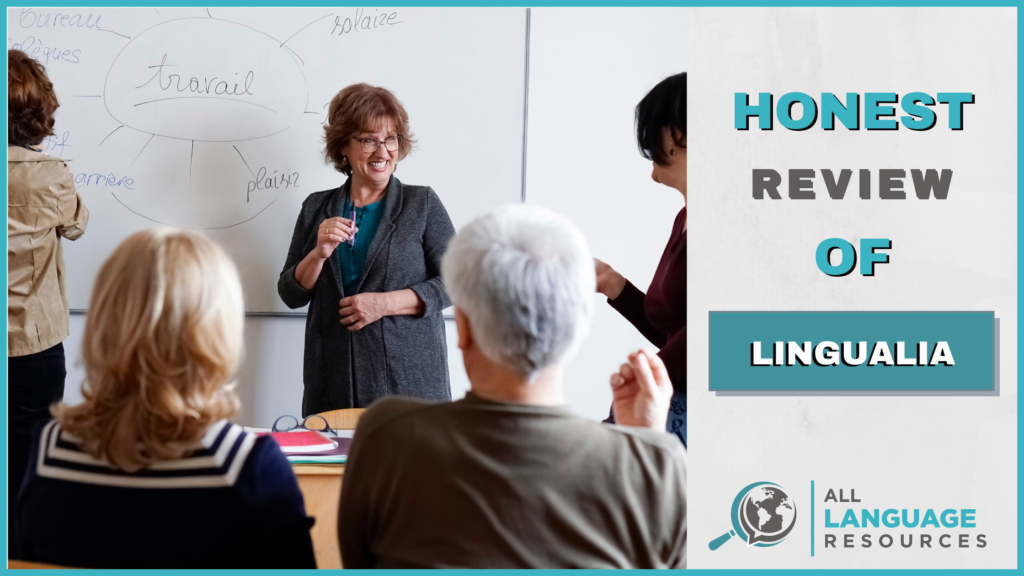Lingualia
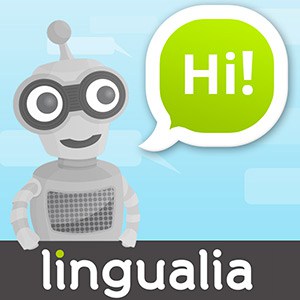
Summary
Lingualia is an online language-learning app targeted toward learners of English and Spanish. It utilizes artificial intelligence and its “exclusive Adaptive Learning method” to offer a learning experience that’s somewhat personalized. Practice happens through interactive activities that cover a variety of skills and have an element of gamification. The free version of Lingualia could make a good option for intermediate or advanced learners that want a casual, convenient way to keep their English or Iberian Spanish skills sharp. It probably isn’t the best option for beginners, those looking for a one-stop-shop resource, or students of Latin American Spanish.
It’s designed well and fun to use, but machine translations aren’t always accurate and the adaptive learning method could be better.
Practice is varied and the courses cover a lot of material, but it’s doubtful you’d actually reach a B2 level.
Great features and amount of content available for free, but I think the subscription prices are too high.
I Like
- Male and female native speaker audio.
- It’s fun to use.
- Potential for human feedback on writing.
I Don’t Like
- There are no speaking exercises.
- Review opportunities are limited.
- The community doesn’t seem very active.
Price
A limited version of the resource is available for free. Access to all features is available for a recurring subscription:
1 month: $25
3 months: $45 ($15/month)
6 months: $59.70 ($9.95/month)
Adaptive learning! Artificial intelligence! Personalized learning experience!
Buzzwords like these accompany all sorts of language-learning resources, some of them mighty and some, well, not so mighty.
It can take some to figure out just where a language-learning tool falls on the spectrum, and that’s why I spent about a week with Lingualia — to see what it’s really all about.

The friendly wide-eyed robot you see here is named Lingu, a characterization of Lingualia’s adaptive learning AI.
I don’t necessarily think the AI used in the Lingualia program lives up to the hype it enjoys in advertising (no offense, Lingu), but that isn’t to say the platform is without merit. I was impressed with some aspects of the platform and think the free version could make a valuable resource for the right learner.
Getting Started With Lingualia
The process is incredibly simple; all you’ll need is an email address or Facebook account to sign up. After providing one of these, you’ll need to select your target language (Spanish or English), your level, how many hours per week you’d like to study, and your motivation for learning.
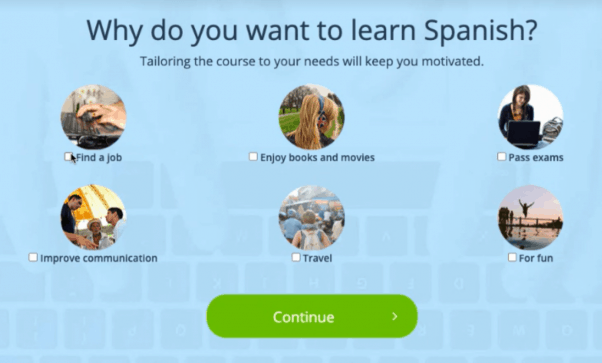
Lingu (the AI learning technology) supposedly uses this information to tailor the learning experience to your needs by selecting relevant vocabulary and setting reasonable study goals.
There’s no placement test, unfortunately, which the platform apparently used to offer. There’s also no way to jump between lessons or units within a level non-sequentially, but it’s easy enough to switch between difficulty levels if you find the one you’re at isn’t quite right.
The Lingualia Layout
The interface design is simple, fun, and casual. I really appreciate resources that don’t require a whole lot of instruction before you can begin to navigate them yourself, and this is one of them.
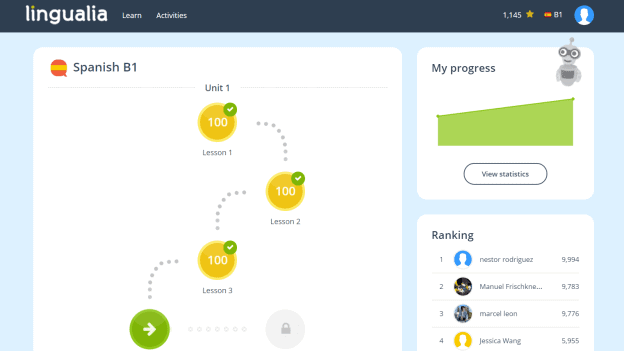
There are only two main sections of the platform: Learn and Activities. The above image shows the Learn section, and it’s where you can navigate through the lessons and units that make up each course. There are ten units and 50 lessons per course.
You’ll also see a basic progress meter and a leaderboard on the right hand of the screen. These are simple additions that may not add a lot of academic value to the course, but I enjoy them all the same. They certainly won’t hurt motivation.
Selecting “View Statistics” in the My Progress window on this page brings up some data related to your studies.
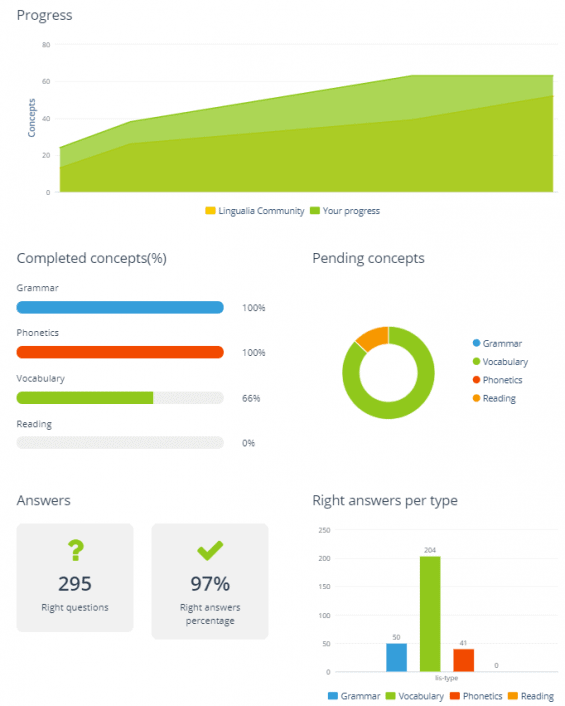
There isn’t a ton of explicit info regarding the “concepts” on this page; from what I can tell, they’re language items (a word, phrase, or grammar point) that you’ve encountered, and the percentage is your level of mastery over the item. As you practice with Lingualia and correctly use these concepts, the percentage increases until you’ve successfully “learned” it.
These statistics don’t update in real time, which makes them slightly less motivating, and I’m not sure what’s going on in the Pending concepts graph; it was often left blank, occasionally reappearing.
I also never came across any reading exercises, even after completing seven lessons across different levels.
The ranking leaderboard is fun and shows just how many people actively use Lingualia (or don’t). After just two days of use, I was ranked higher than 99% of Lingualia users (for the last seven days) and #227.
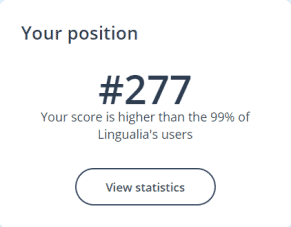
Within a couple more days of casual use, I made it to #45 on the leaderboard.
Lessons
The lessons are where the learning happens with Lingualia, and I was mostly impressed with the content.
Each lesson is made up of three sections: Theory, Practice, and Checkpoint.
Theory
The Theory section is where learners are exposed to new language and receive practice in several skills.
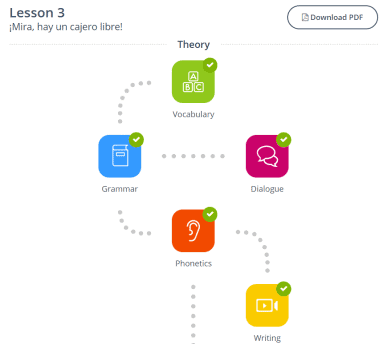
This part of each lesson is structured logically. You’ll begin with some new vocabulary items, move on to a new grammar concept with which you can use these words, and then progress to a dialogue, a short phonetics lesson, and writing practice.
It’s very important to note that all explanations and definitions are in your target language. I think this is great for learners that are more advanced and want to get lots of exposure to the language they’re learning, but beginners will struggle and probably need to lean heavily on an online dictionary like SpanishDict.
There’s also a built-in translation tool that you could use to translate text explanations throughout the course.
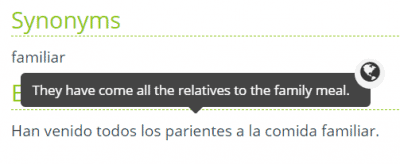
This tool can be used for many languages, but expect some awkward results from these machine translations. Idioms don’t fare particularly well with this method of translation. Still, it usually works well enough for getting the gist of things.
Vocabulary
The first activities in each unit are focused on new vocabulary words.
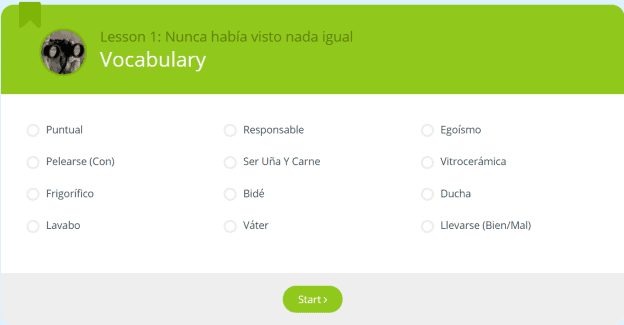
You’ll get to listen to each word, read its definition, see synonyms and/or antonyms, and read and listen to an example sentence. There’s also a picture that accompanies each word. I think this method for communicating meaning is fairly thorough and effective; I almost never had any doubt about a word’s meaning after reading the description.
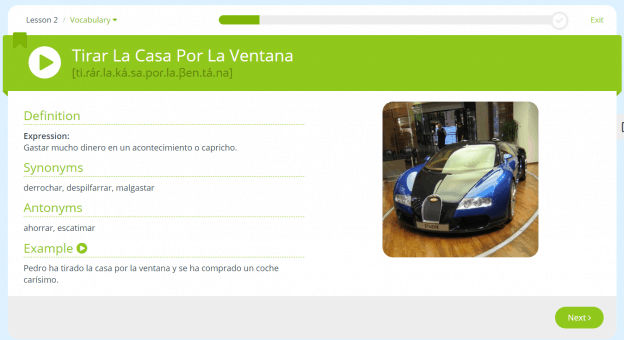
After reading several word descriptions, you’ll take part in some practice activities that test your understanding.
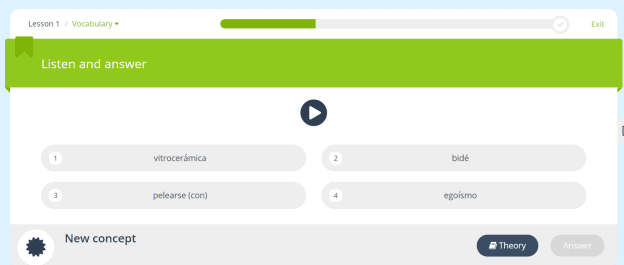
There are multiple-choice activities that test your ability to listen for a word as well as those that check for understanding of meaning.
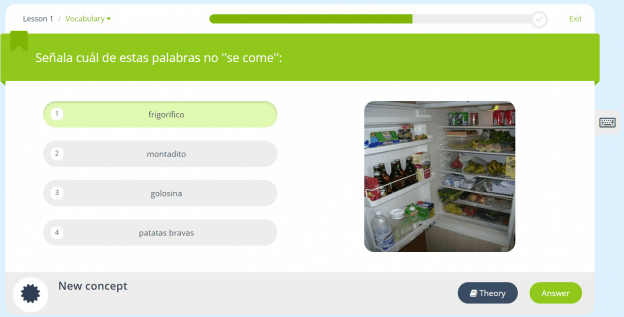
These exercises are pretty basic, but they’re fun to progress through and do a good job of providing repeat exposure to new words. Answering incorrectly means you’ll come across the relevant vocabulary term more frequently until you’ve answered it correctly several times in a row.
There are also exercises that ask you to write the correct term.
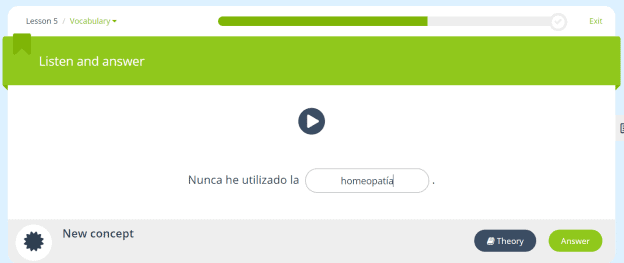
Selecting the Theory button reveals the description page of the vocabulary word: its definition, synonyms, picture, and an example sentence.
Grammar
I bet you could guess what’s covered in this section!
It’s grammar.
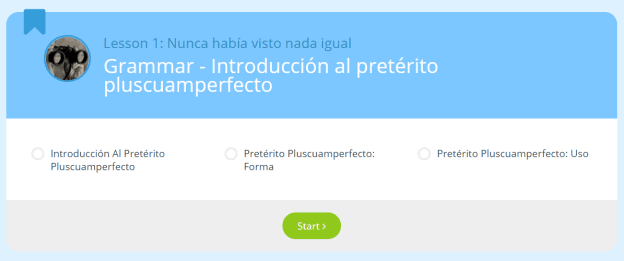
Each lesson has a well-defined grammar focus with explanations, examples, and a couple of practice opportunities.
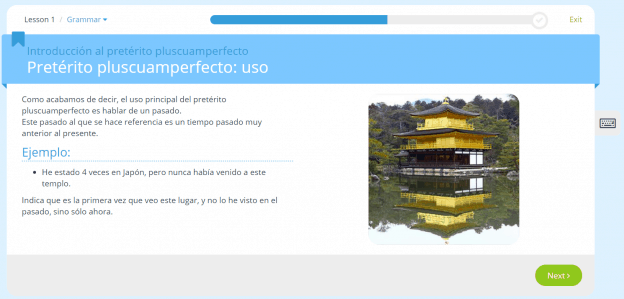
The grammar section is actually quite short; after a decent explanation and some examples, you’ll only practice the new material a couple of times in activities that are similar to those in the vocabulary section. You will, however, get more exposure to the relevant grammar structure in subsequent sections of the lesson.
Dialogue
This is an area in which I wish the resource offered a little bit more guidance.
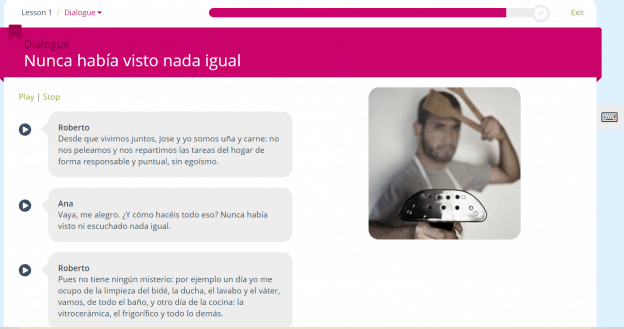
The dialogues in the lessons use a bunch of words and grammar structures from the previous sections. They’re read aloud by native speakers at native or near-native speeds, and I think they make for a great way to get authentic listening and reading practice. They’re also great for getting to see the concepts you’ve learned in a natural context.
I don’t like the fact that there’s no prescribed method for interacting with the dialogue. There’s a play button, but no other controls or instructions. I found myself reading the dialogue out loud to practice, but you could easily listen to the dialogue once and then move on, which I don’t think takes advantage of the practice potential that the dialogues offer.
Phonetics
The material in this section is varied and covers things like spelling rules, paronyms, and words with multiple meanings.
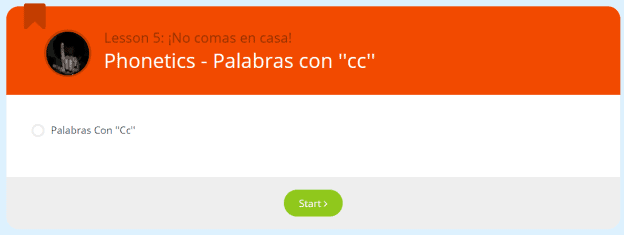
You wont need to spend a lot of time on this section, but it’s a nice way to get some extra instruction that doesn’t quite fall into the other practice categories. Practice exercises are multiple-choice and fill-in-the-gap questions.
Writing
This is a feature that’s got some potential to be really useful. The exercise asks learners to provide a written response to a prompt which other users can then read and provide feedback.
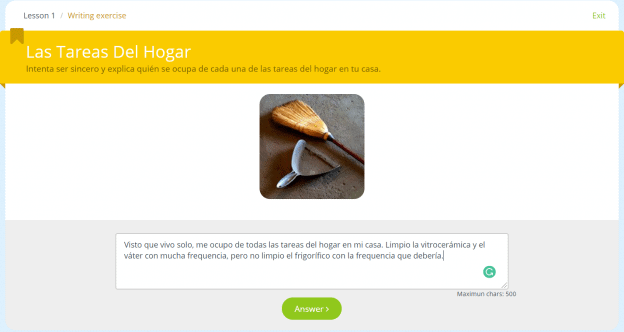
The prompts are related to the lesson and offer a chance to practice the language points you’ve just learned. I think this type of practice is really valuable — you get a chance to use what you’ve learned to make your own, authentic construction. Using your target language to express yourself is kind of what language learning is all about!
There are a lot of resources that don’t offer this type of practice, so I was pleasantly surprised to see it here. Of course, the success of practice like this really hinges on getting quality feedback from others, and I didn’t receive any in the week that I was using the resource.
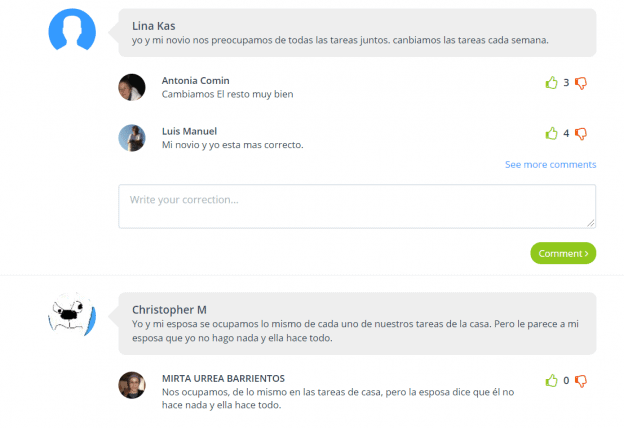
You can see that others have received corrections, and I did my part and corrected a few, but there are no dates next to the submissions or corrections. It’s hard to tell how active the community is in providing corrections — without reasonably speedy feedback, this feature loses a lot of value!
Practice
This section is essentially an overall review of the material learned in the current lesson. Practice happens in the form of fill-in-the-gap questions and multiple-choice quizzes.
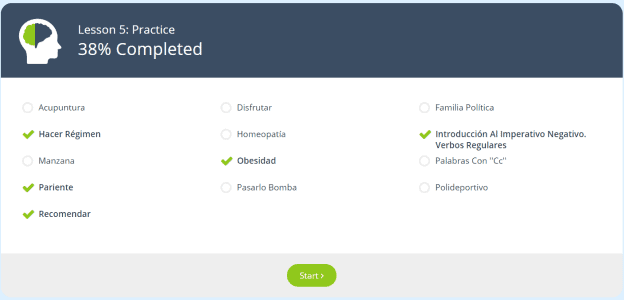
It takes three rounds of questions to complete this section, and you’ll have to answer enough questions correctly to progress through each round.
Checkpoint
This is the final test at the end of each lesson. You’ll be tested on your understanding of most of the material in the lesson and will receive a score based on your performance.
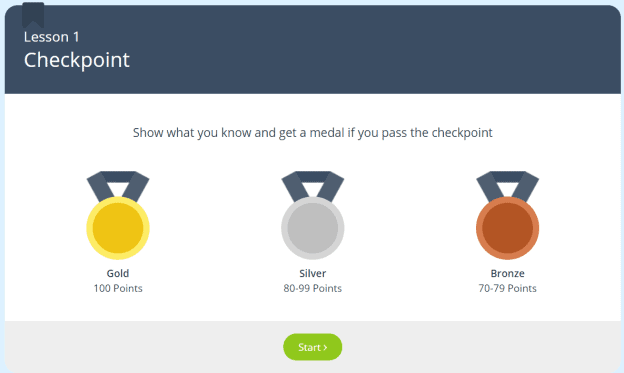
This is also the first place I came across this mix-and-match exercise.
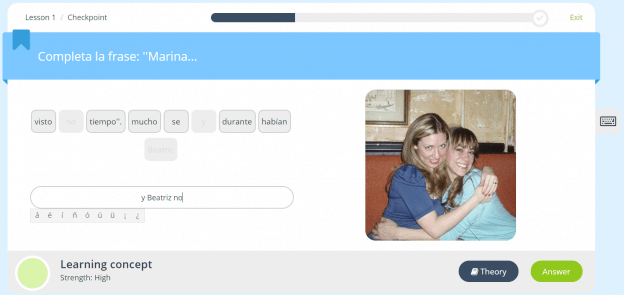
If you want to improve your score, you’re free to retake the test. The questions are all the same, though, which means retaking it isn’t the best way to measure improvement.
After completing the checkpoint and receiving your score, you’ll get to see a detailed breakdown of your performance. I’m not sure if there’s much utility to this, but hey, it looks nice.

Activities
In addition to the Learn page, the other main page on the Lingualia platform is called Activities. This is where learners can help others by commenting on answers to writing questions, offering corrections or encouragement.
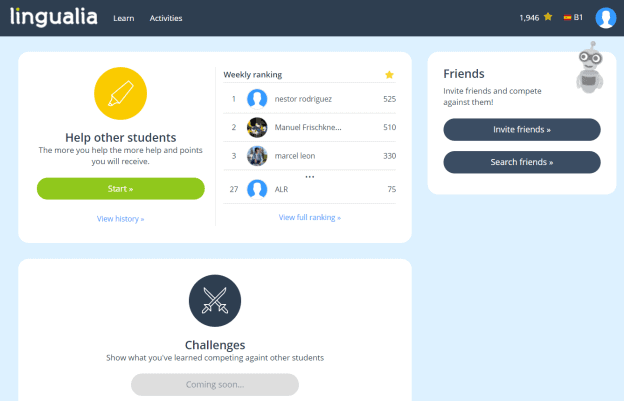
You can also invite friends by sharing a link with them or by sending a social media message directly from the platform. Or, if you’d rather, you can search existing users for friends or browse freely and start following whoever you like. I followed a few people but was never followed back (not holding any grudges, I promise) so I can’t be sure what following actually entails, but it seems to be that you’d be able to easily compare your weekly progress with theirs, adding a more personal competitive element to study.
The Challenges section is “Coming soon…” at the time of writing.
Pricing: Basic vs. Premium
It’s free to make an account with Lingualia, and opting to pay for a recurring subscription unlocks some extra features.
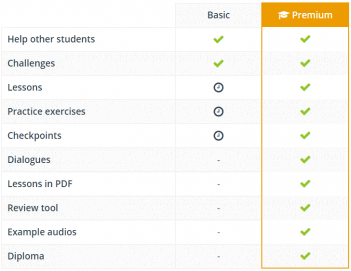
The above table shows what the differences are between the Basic and Premium memberships, but it doesn’t exactly align with my experience testing both types of accounts.
For example, I had what seemed to be the exact same access to dialogues and example audios with the free account and the Premium account. I also couldn’t find any extra “Review tool” while using the Premium version.
These little inconsistencies are unfortunately common throughout the Lingualia platform. More than once I came across strange, illogical wording and messages that I don’t imagine learners are intended to see. Take this notification and call to action, for example:
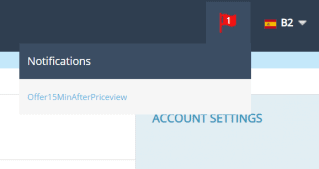
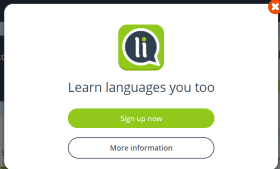
They give the resource something of an unfinished feeling, which is strange, considering its been available for at least seven years.
(By the way, see that notification? At the time of writing, you’ll get offered a 50% discount on three-month and six-month subscriptions 15 minutes after viewing the price!)
Oddities aside, the rest of the table showing differences between membership types is accurate. The biggest difference between them is that you’ll have to wait a full eight hours between completing consecutive lessons when using the free version.
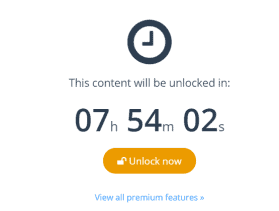
You also won’t have access to downloadable PDFs with the free version, but I didn’t find them super helpful anyway.
Here are the recurring subscriptions prices:

Frankly, I think these prices are far too high for what comes with a Premium Lingualia membership. The free version is pretty great, and completing one lesson per day is probably the right way to use the resource in my opinion.
Do note that these subscriptions will automatically renew each pay period until you cancel them.
Alternatives
Lingualia isn’t exactly in a league of its own. There are scores (okay, hundreds) of gamified, inexpensive or free resources for learning Spanish and English. We’ve looked at quite a few, and I’ll list some that we think are worth considering below.
It’s also worth noting that, even if Lingualia sounds like just the thing for you, you’re probably best off including some supplementary resources in your study plan to get a well-rounded education.
Duolingo
For free, gamified language practice, Duolingo is certainly what comes to my mind first. It’s arguably the most popular language-learning resource out there, and there’s no wondering why. Totally free to use, courses available in dozens of languages, and relatively high entertainment value are some of its most appealing features.
The audio, immersive quality, and integrated grammar explanations are all better in Lingualia in my opinion, but I think Duolingo is much better for beginners and at providing practice that’s fun and convenient. Here’s our full review of Duolingo.
LingoDeer
Similar to Lingualia and Duolingo, LingoDeer is all about convenient, gamified practice. I think it lies somewhere between its two cousins in terms of convenience, thoroughness, and price. LingoDeer has quality course structure, solid audio, varied practice, and it’s cheaper than a Premium membership to Lingualia (but it isn’t free!).
If you’re okay paying for a subscription and are looking for something with better structure than Duolingo, I’d go with LingoDeer over Lingualia. If you’re after something that’s free, either Duolingo or Lingualia could be the right move. We wrote a full review of LingoDeer.
Anki
Another free resource! This is one that works exceptionally well as a complementary resource and could fit nicely into just about any study plan. It leverages a spaced repetition system (SRS) and complete customizability to offer efficient vocabulary practice that you can tailor specifically to your needs.
There is a bit of a learning curve to getting the most out of Anki, but you can also opt to use pre-made decks instead of making your own. Plenty of decks are available for learners of Spanish. Read our mini review of Anki.
italki
This is another resource that fits nicely into just about any study plan. It’s primarily an online database of language tutors, and it’s massive. The high number of teachers available means it’s usually very easy to find teachers that fit your learning style, scheduling constraints, and price range. Speaking with a real human who can provide you with real-time, nuanced feedback is invaluable.
The italki app also boasts some great community features that are free to use: You can get feedback on your writing or pronunciation from other users, find language exchange partners, or get answers to your questions. Read our full review of italki here.
Still haven’t found what you’re looking for? These certainly aren’t your only options! Check out our favorite resources for learning Spanish and English.
Final Thoughts
I like Lingualia. If I were focused on Iberian Spanish, I’d probably continue to complete a lesson every once in a while just to stay engaged with the language.
Practice time limits aside, it offers a lot for free, and having all of the instructions in Spanish is great for more advanced learners. I also had fun using it.
The reasons I wouldn’t pay for it are that I think the price is too high, the review opportunities aren’t comprehensive enough, and the community doesn’t seem to be very active.
The Lingualia YouTube channel does nothing to dispel the program’s ghost town vibe, having posted no videos in the last seven years. The same goes for the platform’s Facebook page, which hasn’t been active for two years, and only sparsely so before then.
In short: I don’t think most people should go out and pay for a subscription to Lingualia, but the free version could make a decent casual study companion for some non-beginner learners.

